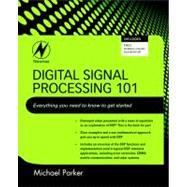Digital Signal Processing 101: Everything You Need to Know to Get Started
, by Parker, Michael- ISBN: 9781856179218 | 1856179214
- Cover: Paperback
- Copyright: 4/5/2010
DSP is utilized in just about every electronic system or device. DSP is taking one piece of information be it data, image, video, or audio, most likely compressing, sending, and filtering it to another location within your application to appear in the form of a document, picture or video.Like Smith before it, this book is different to most on the market by following a popular applied approach to this tricky subject, and will be the perfect starting point for engineers who need to get into DSP from the ground floor. This book starts with the absolute basics of this integral process.No experience is expected and with no prior knowledge taken for granted, a refresher chapter on complex numbers and trigonometry can be found at the very beginning of the material. Real-world worked examples, reference designs, and tools - including online applets that enable readers to visualize key principles - complete a package that will help engineers who that needs to learn anew or refresh their memory on this essential technology as they move to projects that require DSP familiarity. No EE degree? Rusty algebra? Assuming nothing, it starts by answering the question: what is DSP, and guides readers who need to understand DSP to a level where they can communicate with confidence with more experienced DSPers, and be ready to move on to more advanced material Breaks down the complex design and development of DSPs into easy-to-learn building blocks, without using or requiring the complex or involved math of other so called introductory titles. This book speaks the engineer's language, but does not assume they have - or want - the detailed math the developers require. Step-by-step instructions, illustrations and numerous examples fill the pages, with clear worked application example and online support tools to allow readers to visualize, practice and implement DSP using simple FPGA applications.






